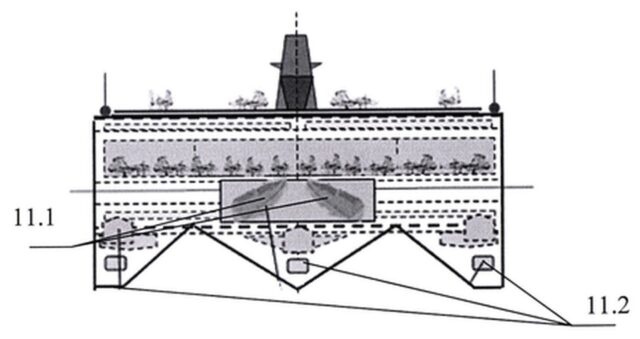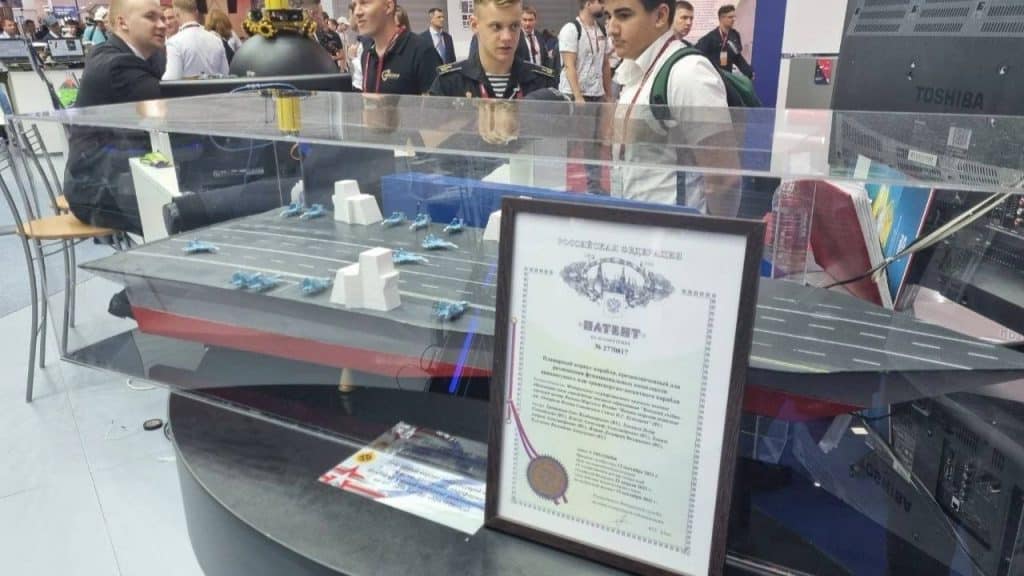Yesterday we wrote about the Arktur submarine concept presented at the Armija-2022 military-technical forum. Even though it is an avant-garde project, it cannot be denied coherence and (at least from the outside) logic. Perhaps in other realities it could turn into a real ship. Against this background, the vision of the aircraft carrier Koktiebiel looks rather like a poor and ill-considered joke.
In fact, it is difficult to compare Koktiebel to other modern airships, and it is not even known where to begin his description. The first thing that draws attention, however, is the flight deck, which has abandoned the two-axis (“oblique”) system. Instead, a circuit is used that should perhaps be called multi-band. The model shows that the aviation component will have at its disposal three parallel runways, which can probably be used in any combination to simultaneously receive aircraft and launch them into the air.
-ADVERTISEMENT-
That’s fine, it’s an unorthodox solution, but it also makes no sense. The possibility of sending combat aircraft into the air in threes is a considerable advantage in an airship. The problem is that it is not very clear how this would be done. The model does not show catapults, of course there is no starting ramp, and yet the aviation component is clearly based on the Su-33. There are also no exhaust gas deflectors, which means that no work can be carried out behind the taking off planes.
Let’s say we consider this doubt in favor of the Russians. Maybe they forgot to paint the appropriate lines on the model? After all, there are also no places for aircraft lifts, which need to be placed somewhere and which are visible in the drawings. In addition, the broken line running theoretically along the longitudinal axis of the deck does not hit its tip. So maybe the whole thing is actually painted “piss off”. But this will not help them explain themselves from completely pointless space management.
First of all, it is impossible to understand why the deck was pointed. After all, it is not without reason that the flight decks of normal aircraft carriers end with an edge perpendicular to the direction of take-off of planes. The point is for the wheels to lift off the ground at the same time and to avoid undesirable tilting onto one wing. In addition, the edge of the flight deck breaks not at one point, but at two points, which unnecessarily (perhaps for style?) Limits the available space.
The use of three superstructures seems to be a completely nonsensical idea. Although there has been a recent fashion for aircraft carriers with two superstructures (we wrote about the advantages of such a layout and the separation of certain functions in this article), it is difficult to guess why who needs a third superstructure instead of, say, an appropriate enlargement of the other two. And even if three are absolutely, necessarily and unconditionally required – elementary logic requires them to be placed on one side. The second should be completely empty so that planes which for some reason are unable to complete the landing maneuver can go sideways and go for the second lap.

One of the patent drawings shows the arrangement of the aerial lifts. However, he points out that the jacks come in different sizes. In addition, there is also a different contour of the flight deck and … a superstructure in the very center of it.
(Rossijskij patient 2022 days after MPK B63B3 / 18 B63B3 / 00)
Okay, the flight deck is as pointless as the Skywalker. Revival. Perhaps at least he was placed on some decent hull?
Where there! Let’s start with the fact that the ship is to be truly Russian. Length – 350 meters on the waterline and 390 meters overall length (60 meters more than Ford aircraft carriers), width 90 meters (12 meters more than Ford), displacement 80,000 tons (20,000 less), propulsion provided by propellers water-jet. At least that should provide plenty of space for the aviation component, right? Again: where there! Koktiebiel is supposed to be a trimaran.
It’s hard to believe, but below the flight deck this ship is even dumber than above. One of the main factors limiting the combat capabilities of an aircraft is the amount of space on board and in hangars. The problem of space management in the context of introducing a new type of aircraft (F-35C) into service was one of the key issues of the USS Carl Vinson (CVN 70) cruise on the Pacific Ocean, completed in February. The Americans’ conclusion on this issue is simple and unchanged for several decades: there is no such thing as “too much space” on an aircraft carrier.

As if the whole concept was not strange enough, the patent drawing allows for the carriage of a pair of landing boats (No. 11.1; propellers marked with No. 11.2). Fortunately, this seems to have been abandoned in the model.
(Rossijskij patient 2022 days after MPK B63B3 / 18 B63B3 / 00)
That’s why airships have bulky, boxy hulls that can hold as many people and equipment as possible. The use of a trimaran (or even a catamaran) system is contrary to the fundamental needs of a ship of this class. This could be compared to an off-road car that would have ground clearance like a Formula 1 car.
Let us add that this framed paper displayed by the showcase is not a diploma. It is a patent for a planar corabal body (planar – that is, without curves – a ship’s hull); you can read the whole thing here. And so that there is no ambiguity: the concept itself is not stupid. And contrary to what we wrote in the introduction, it is not ill-conceived. But it’s stupid to design an aircraft carrier this way.
The Russians could name this project – after the earlier cannon (Tsar cannon), bell (Tsar-kolokoł) or bomb (Car-bomb) – Tsar-avianosiec. It would even be cute. But they named him Koktiebiel instead. In honor of the city of Koktebel in the Crimea. I wonder if the project waits for the liberation of Crimea from Russian occupation (as it might as well be forgotten in a week’s time), its authors will hastily change its name. We suggest: Kulfon. Because why not?
When writing about Arcturus, we recalled the former Waran concept of the light aircraft carrier, in which one could see an attempt to rationalize Russia’s carrier ambitions. But Koktiebiel is in line with the old dream of super-aircraft carriers at least on par with American designs. Closer to the project of the nuclear-powered aircraft carrier 23000E Storm. It was supposed to be 330 meters long and 100,000 tons of displacement, and its construction was to start between 2019 and 2025. Well, at least there was a reasonable arrangement of the lifts.
#Russia has designed a new class of supercarrier, the Shtorm (Project 23000E) http://t.co/xUFizE4K08 #navy #military pic.twitter.com/U4GLQ1RIps
– Nick de Larrinaga (@NickdeLarrinaga) May 15, 2015
See also: Somalia: Machine guns against locusts
ANNA News

